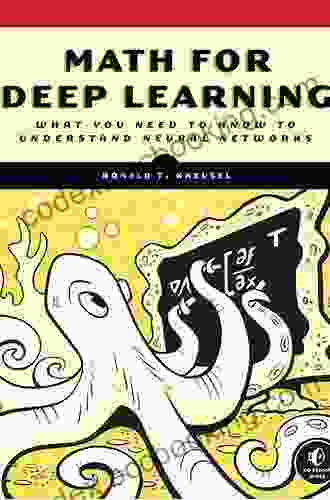Math for Deep Learning: A Comprehensive Guide to the Mathematical Foundations

Welcome to the realm of deep learning, where machines possess the extraordinary ability to learn and perform complex tasks once thought impossible. At the core of this transformative technology lies a solid understanding of mathematics. Math for Deep Learning provides a comprehensive guide to the essential mathematical concepts and techniques that empower data scientists, machine learning engineers, and students to master the foundations of modern AI.
4.5 out of 5
| Language | : | English |
| File size | : | 26048 KB |
| Text-to-Speech | : | Enabled |
| Screen Reader | : | Supported |
| Enhanced typesetting | : | Enabled |
| Print length | : | 345 pages |
Linear Algebra: The Language of Deep Learning
Linear algebra serves as the fundamental language for expressing and manipulating deep learning models. Through matrices and vectors, linear algebra enables the representation of complex relationships between data. This article delves into:
- Matrix operations: addition, subtraction, multiplication, and their algebraic properties
- Vector spaces: their definition, basis vectors, and dimensionality
- Linear transformations: mappings between vector spaces and their applications in deep learning
- Eigenvalues, eigenvectors, and singular value decomposition: crucial concepts for understanding the behavior of matrices
Calculus: The Tool for Optimization
Calculus provides the necessary tools for optimizing deep learning models. Differential calculus allows the computation of derivatives, revealing the gradient of a loss function. This knowledge guides the learning process by adjusting the model's weights in the direction of lower error. Integral calculus, on the other hand, supports the calculation of integrals, enabling the derivation of various deep learning algorithms.
- Partial derivatives: understanding the rate of change of a function with respect to multiple variables
- Chain rule: a powerful technique for calculating derivatives of complex functions
- Optimization techniques: gradient descent, backpropagation, and their role in deep learning
- Convolutional neural networks: a specialized form of deep learning that utilizes convolutions, a mathematical operation inspired by linear algebra
Probability: The Foundation of Uncertainty
Probability theory provides a mathematical framework for modeling and quantifying uncertainty. In deep learning, probability is used to represent the likelihood of events, such as the probability of a given input belonging to a specific class. This article covers:
- Conditional probability: understanding the probability of one event given the occurrence of another
- Bayes' rule: a fundamental theorem in probability that enables the calculation of posterior probabilities
- Random variables: their distribution, expectation, and variance
- Gaussian distribution: a bell-shaped distribution commonly encountered in deep learning
Optimization: The Search for Optimal Solutions
Optimization algorithms are the workhorses of deep learning, tasked with finding the optimal set of model parameters that minimizes the loss function. This article examines:
- Gradient descent: a fundamental optimization algorithm used in deep learning
- Momentum and adaptive learning rate optimization: techniques that enhance the performance of gradient descent
- Regularization: methods to prevent overfitting, a common problem in deep learning
- Bayesian optimization: an advanced technique for finding optimal hyperparameters, the settings that govern the behavior of a deep learning model
Math for Deep Learning is an indispensable resource for anyone seeking to unlock the full potential of deep learning. By mastering the mathematical concepts and techniques explored in this article, you will gain a solid foundation in the language of modern AI. With a deep understanding of these mathematical principles, you will be empowered to effectively design, implement, and troubleshoot deep learning models, enabling you to harness the transformative power of this technology to solve complex real-world problems.
4.5 out of 5
| Language | : | English |
| File size | : | 26048 KB |
| Text-to-Speech | : | Enabled |
| Screen Reader | : | Supported |
| Enhanced typesetting | : | Enabled |
| Print length | : | 345 pages |
Do you want to contribute by writing guest posts on this blog?
Please contact us and send us a resume of previous articles that you have written.
 Book
Book Novel
Novel Page
Page Chapter
Chapter Text
Text Story
Story Genre
Genre Reader
Reader Library
Library Paperback
Paperback E-book
E-book Magazine
Magazine Newspaper
Newspaper Paragraph
Paragraph Sentence
Sentence Bookmark
Bookmark Shelf
Shelf Glossary
Glossary Bibliography
Bibliography Foreword
Foreword Preface
Preface Synopsis
Synopsis Annotation
Annotation Footnote
Footnote Manuscript
Manuscript Scroll
Scroll Codex
Codex Tome
Tome Bestseller
Bestseller Classics
Classics Library card
Library card Narrative
Narrative Biography
Biography Autobiography
Autobiography Memoir
Memoir Reference
Reference Encyclopedia
Encyclopedia Emily J Taylor
Emily J Taylor Michael Kranish
Michael Kranish Megan Massacre
Megan Massacre Sheri Wall
Sheri Wall Ira Sumner Simmonds
Ira Sumner Simmonds Sangeet Paul Choudary
Sangeet Paul Choudary Hannah Branigan
Hannah Branigan Robb Gilbear
Robb Gilbear Ellen Eagle
Ellen Eagle Emy Dutton
Emy Dutton Eqbal Ahmad
Eqbal Ahmad Emilie Wapnick
Emilie Wapnick Jason Akley
Jason Akley Richard S Post
Richard S Post Randy Smith
Randy Smith Robert M Wachter
Robert M Wachter Jitendra Chouksey
Jitendra Chouksey Ems Publishing
Ems Publishing Margaret Muir
Margaret Muir Mark Chang
Mark Chang
Light bulbAdvertise smarter! Our strategic ad space ensures maximum exposure. Reserve your spot today!

 Lucas ReedUnveiling the "People's History of the Industrial Revolution": A Chronicle of...
Lucas ReedUnveiling the "People's History of the Industrial Revolution": A Chronicle of... Harold PowellFollow ·8.4k
Harold PowellFollow ·8.4k Dashawn HayesFollow ·11.1k
Dashawn HayesFollow ·11.1k Roger TurnerFollow ·4.4k
Roger TurnerFollow ·4.4k Edison MitchellFollow ·15.8k
Edison MitchellFollow ·15.8k Billy FosterFollow ·7.3k
Billy FosterFollow ·7.3k Raymond ChandlerFollow ·12.4k
Raymond ChandlerFollow ·12.4k Fletcher MitchellFollow ·14.5k
Fletcher MitchellFollow ·14.5k Federico García LorcaFollow ·17.5k
Federico García LorcaFollow ·17.5k

 Isaias Blair
Isaias BlairEscape to Sunrise Cottage: A Captivating Read You Won't...
Are you ready for a...

 Bradley Dixon
Bradley DixonWhen Baby Is Born, So Is Mother: A Comprehensive Guide to...
Giving birth is a...

 Mario Simmons
Mario SimmonsPhotographic Journal of Cruise Around South America: A...
Embark on an Extraordinary Expedition ...

 Langston Hughes
Langston HughesDream Achieved: Unlocking the Power Within to Make Your...
In the tapestry...
4.5 out of 5
| Language | : | English |
| File size | : | 26048 KB |
| Text-to-Speech | : | Enabled |
| Screen Reader | : | Supported |
| Enhanced typesetting | : | Enabled |
| Print length | : | 345 pages |













